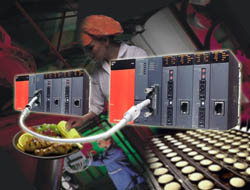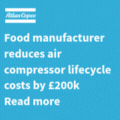
Posted to News on 26th Feb 2007, 20:19
Redundant controls benefit food and drink production
This article explains how the food and drink can benefit from the latest generation of redundant control systems to give affordable dependability.

There are many process industries that have found good cause to embrace the technology of redundant systems but, historically, the food and drink sector has not been one of them. A key reason behind this has, of course, been cost; implementing redundant systems has traditionally relied on the use of custom hardware and bespoke installation, and that does not come cheap.
For the likes of the oil and gas processing sectors or the chemicals industries, there is no choice in the matter, because the result of a control failure can be catastrophic. The cost of the necessary redundant technology is justified by the risk of failure. However, in many other industries – food and drink among them – the same risks simply do not exist, so redundant systems have been seen as an unjustifiable expense.
However, the picture is changing. Manufacturers are coming to realise that defining risk is much more than simply looking at the potential for accidents. There is the monetary cost of downtime in terms of lost production; also the potential damage to reputations when products do not arrive with the customer on time; and the risk of faulty products reaching the customer.
These are particularly pertinent issues within food manufacturing. With routes to market increasingly dominated by the large supermarket chains, food manufacturers are finding their profit margins continually squeezed, to the point where the cost of downtime is becoming very significant indeed. Maintaining the bottom line depends on smooth, continuous production.
Lost production and lost reputation
At the same time, the supermarkets seem to have no qualms about finding alternative suppliers should delivery of goods start to look in any way uncertain. A manufacturer's reputation for reliable delivery is hard won, and easily lost.
But perhaps the most significant of the issues facing the food and drink industry is the risk of flawed or imperfect products finding their way into the distribution chain. The technology to track and trace products is in place and is reliable, but the cost of a product recall is significant, in terms of both lost revenue and damaged reputation. Added to that, we are living in an increasingly litigious society, and the costs of defending and settling any resulting litigation must not be ignored.
HACCP food safety methodology
The food industry is a relatively recent adopter of advanced automation and process control technologies. But in recent times it has embraced the highest levels of control systems as a means of boosting productivity, eliminating the inconsistencies that inevitably result from manual control adjustments, and meeting key HACCP (Hazard Analysis and Critical Control Point) requirements. The HACCP food safety methodology relies on the identification of critical control points (CCPs) in food production and preparation processes. The CCPs are then closely monitored in order to ensure that food is safe for consumption.
Of the seven HACCP principles, four directly address control aspects, covering the defining of CCPs, setting of limits for each CCP, monitoring to ensure each CCP is under control, and taking of corrective action when a CCP is out of control.
Looking at how control technology impacts on food production, a typical scenario starts with raw materials and ingredients stored in a cold storage area. Temperature monitoring and control systems maintain the correct temperature or warn of problems. As production starts, ingredients are weighed into batch bins, with a PLC holding all the recipe data for the given end product. The batch store might be PLC controlled, again with temperature monitoring. As the batch bins are moved to the mixing and cooking environment, extra ingredients are weighed out and added. Recipes and operations are PLC controlled, and effective temperature monitoring is maintained, with all systems networked to monitor CCPs. After cooking, clean-in-place (CIP) operations are also PLC controlled.
The product, meanwhile progresses to filling and packaging, with the batch details printed on the package. Again, all these operations are typically PLC controlled.
PLC plays critical role
With this picture, it is clear that the role of the PLC is vital. If this key component goes down, the problem is not simply one of the process stopping for a short period. If the monitoring of temperature loops, for example, cannot be assured, and if uncertainty arises, then whole batches or bins of ingredients might have to be simply thrown away.
Many of these issues would be readily addressed through the use of redundant controllers, but when such technologies cannot be bought off the shelf, then cost becomes a major issue. Historically there has been a notable lack of standardised redundant controllers that offer the same benefits of processing power, open systems and competitive pricing that users have come to enjoy from conventional automation components.
But the situation is changing. The recently launched QnPRH controller from Mitsubishi has reached a price point that opens up redundant options to virtually all food processing operations. Readily scalable, the QnPRH platform meets the needs of distributed control around food processing lines, with a fully redundant architecture that provides hot standby in critical areas.
Track record
Mitsubishi Electric is one of the largest automation and control companies in the world, with a history of innovation in the development of today's highly reliable technical integrated solutions. Its experience ranges from the smallest and simplest installations to the most demanding where systems interruption cannot even be tolerated. Complementing the QnPRH, Mitsubishi has a suite of software programs designed to provide specific functions. This includes the powerful MX SCADA platform that is already widely used throughout the food and drinks industry.
With the introduction of these latest redundant controllers from Mitsubishi, hardware installation and maintenance costs are being slashed while, at the same time, performance, productivity and reliability are soaring to new levels.




